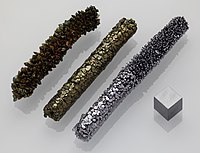
Photo from wikipedia
Vanadium redox flow battery (VRFB) is one of the most promising technologies for grid-scale energy storage applications because of its numerous attractive features. In this study, metal-organic frameworks (MOF)-derived catalysts… Click to show full abstract
Vanadium redox flow battery (VRFB) is one of the most promising technologies for grid-scale energy storage applications because of its numerous attractive features. In this study, metal-organic frameworks (MOF)-derived catalysts (MDC) are fabricated using carbonization techniques at different sintering temperatures. Zirconium-based MOF-derived catalyst annealed at 900 °C exhibits the best electrochemical activity toward VO2+/VO2+ redox couple among all samples. Furthermore, the charge-discharge test confirms that the energy efficiency (EE) of the VRFB assembled with MOF-derived catalyst modified graphite felt (MDC-GF-900) is 3.9% more efficient than the VRFB using the pristine graphite felt at 100 mA cm−2. Moreover, MDC-GF-900 reveals 31% and 107% higher capacity than the pristine GF at 80 and 100 mA cm−2, respectively. The excellent performance of MDC-GF-900 results from the existence of oxygen-containing groups active sites, graphite structure with high conductivity embedded with zirconium oxide, and high specific surface area, which are critical points for promoting the vanadium redox reactions. Because of these advantages, MDC-GF-900 also possesses superior stability performance, which shows no decline of EE even after 100 cycles at 100 mA cm−2.
Journal Title: Catalysts
Year Published: 2021
Link to full text (if available)
Share on Social Media: Sign Up to like & get
recommendations!